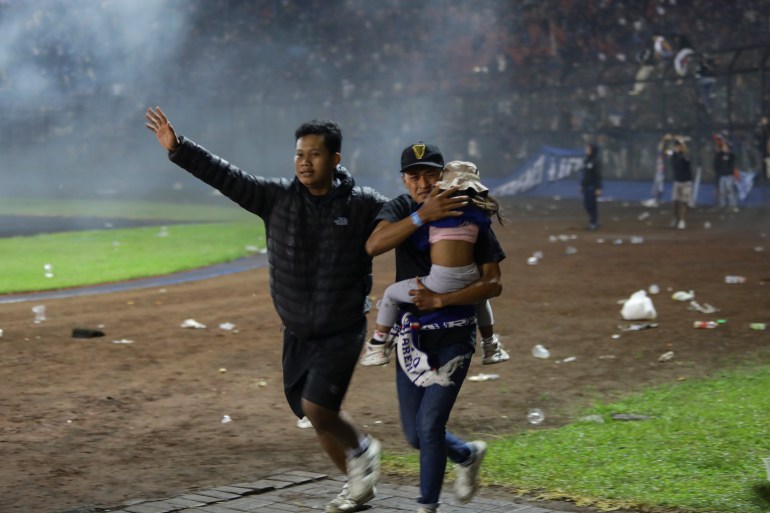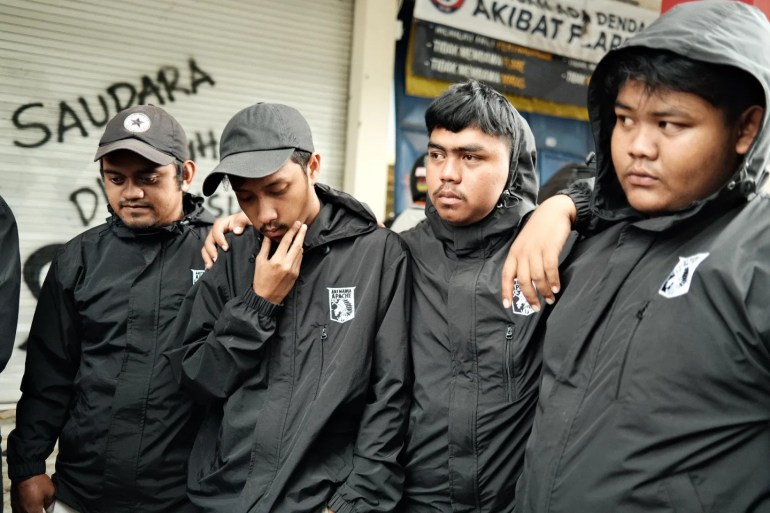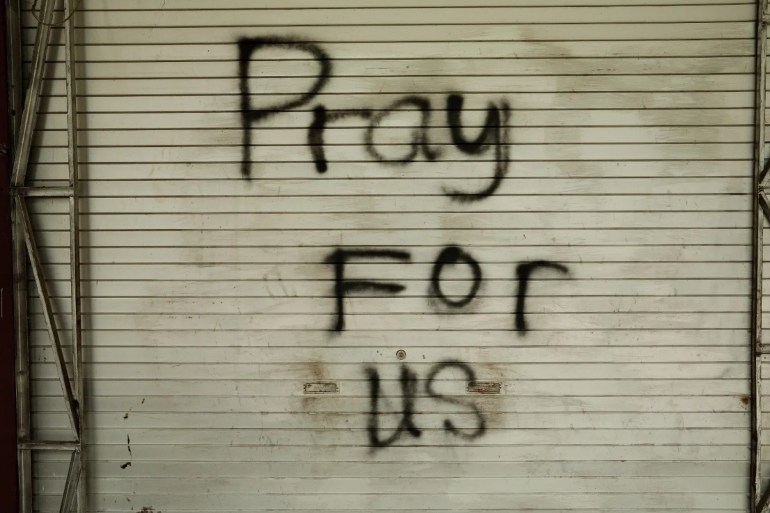Witnesses recount chaos, blame police in Indonesia stadium deaths
Witnesses at Kanjuruhan stadium told of clashes between fans and police, deaths of spectators, and how they survived.
![A man breaks down at a memorial for the victims of Saturday's soccer match stampede in front of gate 13 at the Kanjuruhan Stadium in Malang, Indonesia on Oct 4, 2022 [Achmad Ibrahim/AP]](/wp-content/uploads/2022/10/AP22277147012386.jpg?resize=770%2C513&quality=80)
Malang, Indonesia – Witnesses to the Indonesian football stadium disaster which killed at least 125 people and left hundreds injured have accused police of firing tear gas into spectator stands and blocking gates as people tried to flee the chaos.
One of the deadliest sporting tragedies ever occurred on Saturday evening at the Kanjuruhan football stadium in Indonesia’s East Java province, where witnesses told of violence between fans and police, deaths of spectators, and how they had managed to survive.
Keep reading
list of 4 itemsPhotos: 125 killed in one of Indonesia’s worst football disasters
Timeline: How did Indonesia’s deadly football stampede unfold?
Indonesia announces investigation into Malang football disaster
Two law enforcement officers and at least 17 children were among those killed when panicked supporters fleeing clouds of police tear gas stampeded towards the stadium’s exits leading to people being trampled to death and suffocating in the crush.
Police were “100 percent” to blame, said Fitria Rahmawati, who attended the match in Malang city with her husband and children.
Rahmawati recounted to Al Jazeera the events that unfolded when spectators – some of whom were drunk – breached the barricades and stormed the pitch leading police to respond with the indiscriminate use of tear gas.
The gas was not just targeted at those who invaded the pitch, but also spectators in the stands, she said.
“Why in the hell did they shoot tear gas into the upper grandstand?” she asked.
Her allegations were supported by other witnesses and by a video clip from the football stadium that appeared to show flashes in the upper grandstand followed by white clouds of gas.
“It was horrifying”, Rahmawati said, telling of how she saw police and soldiers hit men and women with batons “until their bones broke”, and how she had witnessed spectators attacking the police and also attack other spectators who tried to stop the violence.
“I have two kids with me, so unfortunately I had to stomp on other people to get out,” she said.
“Eventually I found a way to gate seven, it was open for a couple of minutes and I managed to get out. But then police closed it again and kept shooting tear gas and attacking people from the inside and out.”
‘I have no idea what happened to them’
Tension had started to mount 15 minutes before the final whistle as it became clear that the home team – Arema Football Club – would lose to arch-rivals Persebaya, a club from nearby Surabaya City, said 22-year-old student Tubagus Surya.
Surya had attended the match with seven other university friends, one of whom would be killed in the ensuing carnage.
“Some fans began chanting racist slurs at Persebaya players so the MC started telling the crowd to be calm and go home early,” Surya told Al Jazeera.
“After the siren rang, one fan ran across the field carrying a flag that said ‘You play a s**t game’,” he said.
“That’s when I heard a commander or someone in charge shout ‘Shoot tear gas!’, and they did. The police also started kicking spectators, and spectators attacked the police. It was chaos.”

Hit by tear gas, Surya could not breathe or open his eyes at first. “When I started crying the pain got worse,” he said.
“I saw a woman holding her baby. The baby was suffocating and crying so I took off my jacket and scarf, wrapped it around the baby and dragged both of them out of the section. But then we got separated. I have no idea what happened to them.”
Surya also claimed that the stadium’s gate was open but by the time he got to it, police had blocked it with an iron barricade. When police refused to open the way, fans outside the stadium took action to help those inside to get out.
“We pushed the barricade and shouted at them to let us out because there were so many victims,” Surya said.
“But the police shouted back that they had received a direct command and refused. Fortunately, spectators who were already outside the stadium overpowered them so we could escape.”
Outside the stadium, Surya described a scene of horror.
“I saw some spectators attacking the police and others carrying dead bodies,” he said, describing how those who carried the deceased chanted Muslim prayers that are recited at funerals.
The morning after the disaster, distraught relatives of the missing gathered at local hospitals searching for their loved ones. They included Virta Eka, whose 14-year-old brother, Yanuar Dwi Bramastyo, had died in the tragedy.
“Before the game, he sent a text to our parents for their blessing to go and watch the match,” Eka told Al Jazeera, explaining that her brother had shared his location at a minimart near the stadium where he had met his friends.
That would be the last time her brother – who she called “Tio”, would make contact.
“When I heard news of the riot on Saturday, I thought my brother would be OK because he and his friends are very responsible,” she said, recounting how her brother’s whereabouts were eventually discovered in the early hours of Sunday morning.
“I don’t remember how many hospitals I visited,” she said, telling how she found her brother at a hospital located 5 kilometres (about 3 miles) from the stadium.
“Once I arrived I was told Tio had passed away. I saw his body. He was bruised in many places and had some open wounds … I saw many bodies,” she said.
Eka believes that whoever fired the tear gas is responsible for her brother’s death.
“Tio’s friends are just children but they’re traumatised after seeing their friends die right in front of their eyes. The authorities should offer help for them.”

People are in shock
With provincial hospitals unable to cope, many of the deceased and wounded were transported to Dr Saiful Anwar Hospital in the city of Malang 23km (around 14 miles) north of the stadium.
On Sunday evening, dozens of people still waited outside, praying, sharing information or thumbing through lists of the names of the deceased, and grim photos of unidentified bodies.
Sugeng Nugroho, whose 19-year-old son Rezki was severely injured at the game, was among them.
“At 6pm, Rezki came to my shop to ask for my blessing to watch the match. I gave it to him,” Nugroho told Al Jazeera.
“At 1:30am [18:30 GMT], some of his friends arrived home and my son was not with them. They said police had been shooting tear gas all over the place. People panicked because they could not breathe and tried to escape but the doors were locked and they were unable to get out,” he said.

“I asked his friends to take me to the stadium but we couldn’t find my son or his motorbike. A few hours ago, I learned he is at this hospital and badly injured. He’s in a state of semi-consciousness, highly traumatised and mumbling in his sleep. They have tied him to his bed with restraining belts.”
He, too, believes that police are responsible for his son’s injuries.
“The chaos would not have happened if they did not shoot the tear gas. My son’s friends say they tried to push open the doors at the stadium. But instead of helping them, police punched and kicked them.”
Bayu Amengku Praja, a lecturer in public administration at Malang’s Brawijaya University, said the spectators should not have stormed the pitch, but the police should also not have used tear gas.
“They should have used water cannons instead as it would have been sufficient to control the crowd. People in Malang are in shock because this is a peaceful city with very little crime. We have a lot to learn from this tragedy,” he said.
Malang Provincial Police did not immediately reply to questions about their use of tear gas and the witness reports that gates were open and then blocked.
Indonesian President Joko Widowo has ordered the federal police in Jakarta to investigate the tragedy.
Silent vigil
On Monday afternoon, Indonesian and expatriate team members of the Arema Football Club held a silent vigil at a shrine in the car park outside Kanjuruhan stadium.
They wept openly and comforted each other as they laid flowers at the makeshift memorial while a group of about 200 onlookers gathered around. Afterwards, the team members entered the stadium to pray for the dead amid the wreckage of a sports ground that will likely be forever regarded as a haunted place.
![Members of the Arema football club break down and cry at a shrine built in the car park of Kanjuruhan Stadium during a commemorative service on October 3. 2022 [Al Jazeera]](/wp-content/uploads/2022/10/Members-of-the-Arema-football-club-break-down-and-cry-at-a-shrine-built-in-the-car-park-of-Kanjuruhan-Stadium-during-a-commemorative-service-on-Monday-1.jpeg?w=770&resize=770%2C578)
Tears also flowed freely at Tlogorejo, a village on the banks of a reservoir surrounded by sugarcane plantations an hour’s drive from the stadium. Here the family and friends of another victim, 16-year-old Gabby Setyawardhani, gathered at her parent’s home to pray for her soul.
“My daughter was a good person. Quiet and humble. She would never partake in a riot or break the law,” Gabby’s mother, Hanum Kristin Hamsa, told Al Jazeera.
“She simply went to a football game because she is a fan. According to her friends, she was sitting on the grandstand the last time they saw her,” Hamsa said.
“Who’s to blame for this? I don’t know who to blame,” she added, as tears began to flow.
“Blaming someone will not bring my daughter back.”